November 9, 2025 | 09:19 GMT +7
November 9, 2025 | 09:19 GMT +7
Hotline: 0913.378.918
November 9, 2025 | 09:19 GMT +7
Hotline: 0913.378.918
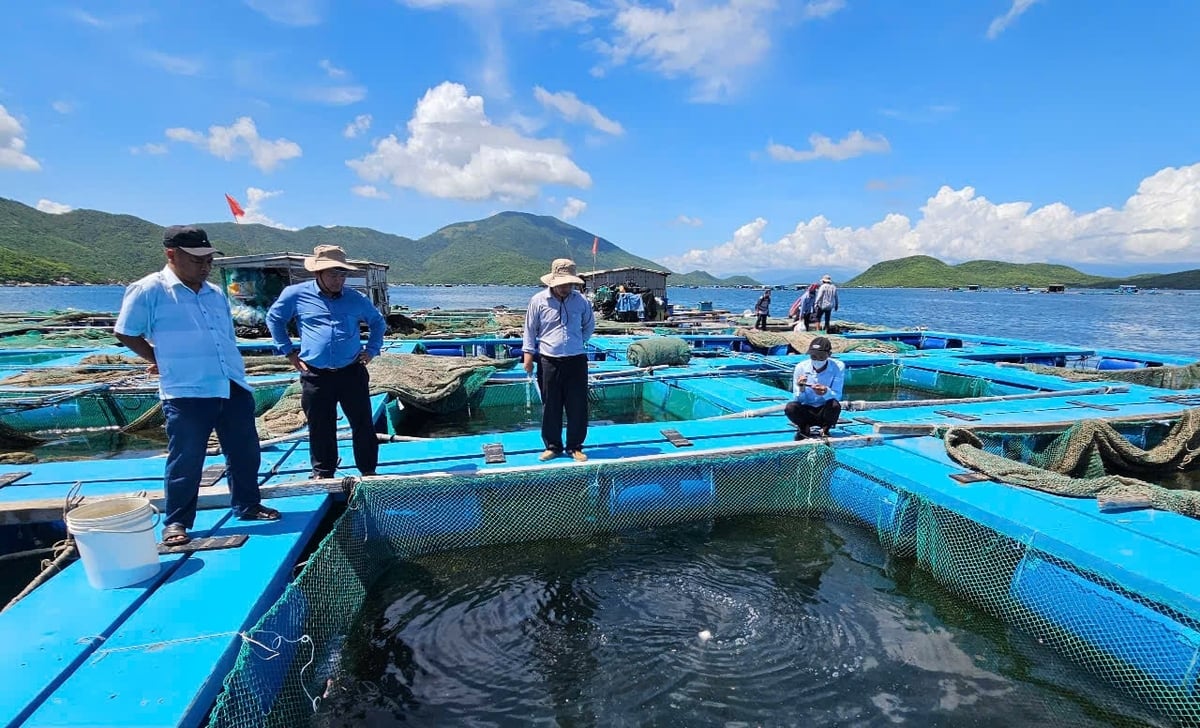
Aquaculture in floating cages in Van Phong bay, Van Ninh district. Photo: KS.
With a coastline stretching 385 km, 200 large and small islands, and numerous bays such as Van Phong, Cam Ranh, Nha Trang, along with the Nha Phu and Thuy Trieu lagoons, Khanh Hoa province has in recent years developed a strong aquaculture industry using floating cages, also known as marine farming.
The farming species are very diverse, but the main ones include lobster and various types of marine fish (barramundi, yellowfin pomfret, cobia, groupers, and other species).
According to the Department of Agriculture and Environment of Khanh Hoa, the province currently has 3,242 aquaculture cages with 140,160 floating cage units. Annually, the marine farming output reaches about 10,000 tons.
Mr. Nguyen Xuan Hoa, a veteran with 30 years of experience from Van Gia town (Van Ninh district), has developed 150 floating cage units for farming marine fish and lobsters. His total annual marine fish harvest is about 40-50 tons, while lobsters yield around 2-3 tons.
Mr. Hoa said that over the years, marine farming has not only brought economic benefits to his family but also created jobs for many local workers. However, this farming profession involves significant risks, especially during rainy season, when unpredictable weather can cause total losses.
In fact, Storm No. 12 in 2017 and Storm No. 9 in 2021 proved the risks by causing severe economic damage to the aquaculture cage farmers in Khanh Hoa province. Storm No. 12 was a horrifying nightmare for fishermen, with winds reaching level 12 and gusts at level 15 accompanied by heavy rain that destroyed cages for farming shrimp and fish at sea. Many farmers lost billions of dong overnight, becoming completely destitute in an instant.
“Learning from the past storms, in recent years during the rainy and storm season from September to November (lunar calendar), local farmers have proactively reinforced their floating cages carefully. At the same time, they closely monitor weather developments through early disaster forecasts and warnings to promptly harvest shrimp and fish at marketable sizes, as well as move people safely to shore to avoid damage when tropical depressions or storms make direct landfall,” Mr. Hoa shared, affirming that hydrometeorological forecasting is essential and important for marine farming. This has been a solution he regularly updates during the storm season in recent years to improve production efficiency.
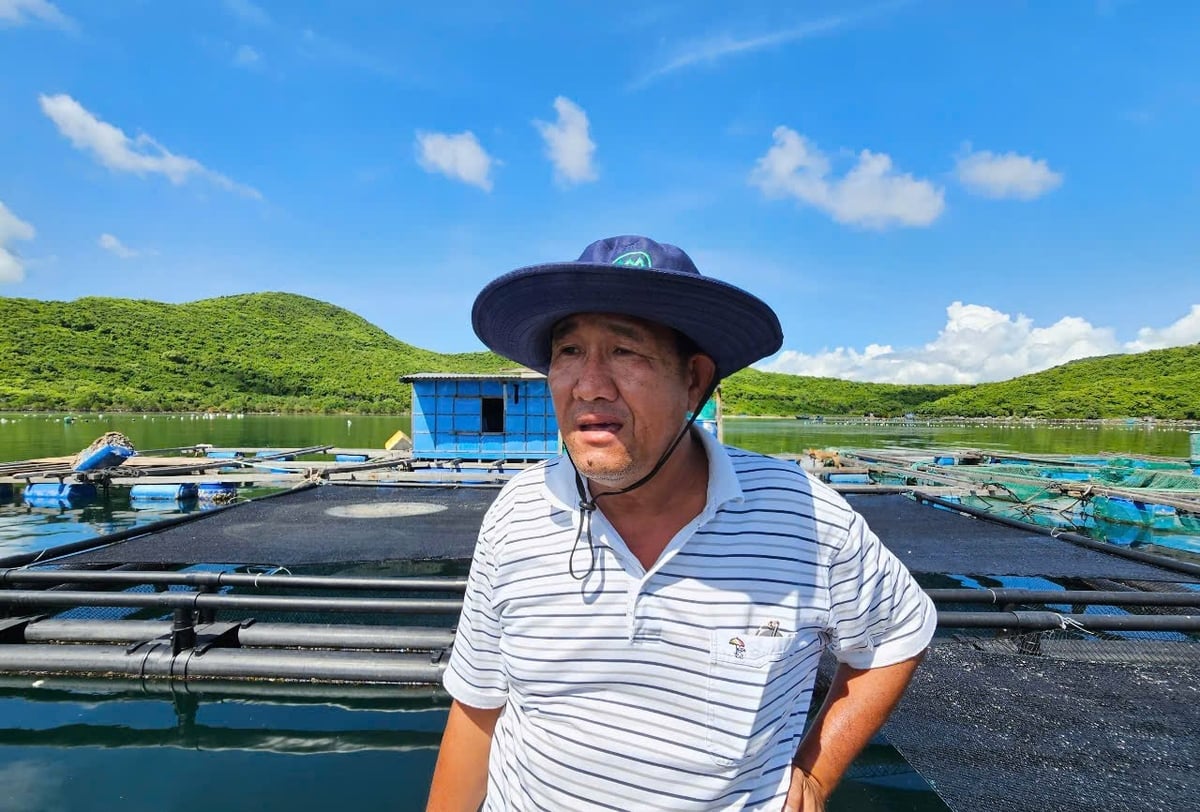
Mr. Nguyen Xuan Hoa said that to minimize losses in aquaculture, he closely monitors weather forecasts. Photo: KS.
Similarly, Mr. Nguyen Thanh Sang from Van Luong commune (Van Ninh district), who has been engaged in marine farming in Van Phong bay for nearly 20 years, has now developed 150 cage units primarily farming fish, with a total annual harvest of about 50-70 tons.
Mr. Sang said that after the heavy damage caused by Storm No. 12, in recent years, he has remained highly vigilant, frequently updating weather forecasts during the storm season to proactively respond.
“From my observations, the meteorological and hydrological forecasts are relatively accurate. Thanks to that, our family’s shrimp and fish farming has significantly reduced damage in recent years,” Mr. Sang shared.
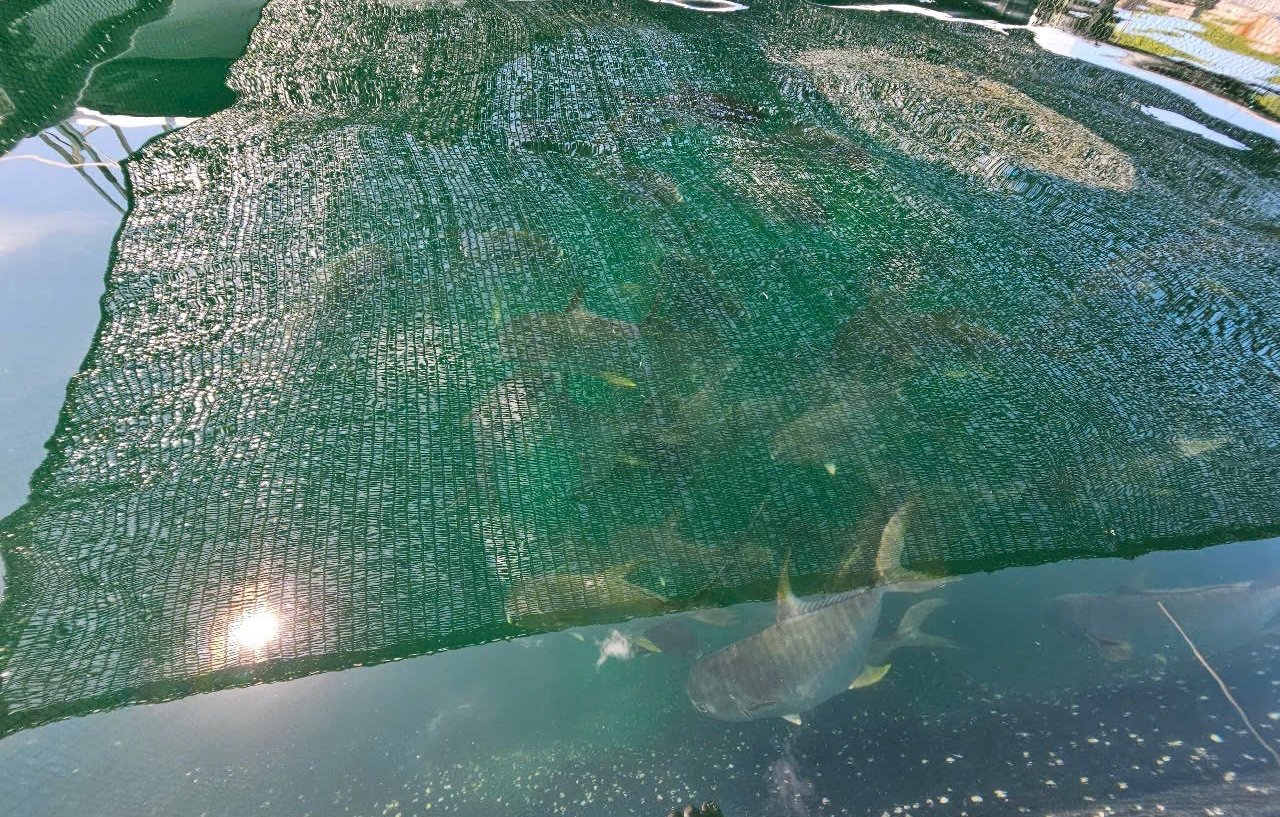
During the stormy season, farmers cover nets over the cage surfaces to prevent the fish from escaping. Photo: KS.
Mr. Le Xuan Thai, Chief of Office of the Steering Committee for Natural Disaster Prevention, Search and Rescue, and Civil Defense of Khanh Hoa province, stated that weather forecasting plays a crucial role in the sustainable development of the aquaculture sector. Accurate forecasting and early warnings not only help protect property and reduce risks for local residents but also improve production efficiency, ensure sustainability in the context of climate change.
According to Mr. Thai, in recent years, hydrometeorological forecasting for marine aquaculture in the province has seen significant improvements. Specifically, forecasts now issue disaster warnings several days in advance, giving residents and businesses time to prepare and respond.
In addition, forecasts are now localized down to specific farming areas, providing more accurate information on potential natural disasters. This enables residents and businesses to take proactive measures, such as reinforcing cages, covering cage surfaces with nets to prevent fish from escaping, or harvesting shrimp and fish that have reached market size.
“Recent storms and heavy rain forecasts (such as the tropical depression in 2018 and the flood in November 2021) have included detailed predictions of wind levels and rainfall volumes down to the district level with high reliability, helping people to plan timely preventive measures.
Long-term forecasts (monthly, quarterly, seasonal) have also been strengthened, assisting farmers and businesses in selecting the optimal time for stocking, thus avoiding unfavorable weather conditions caused by natural disasters,” Mr. Thai said.
Mr. Tran Van Hung, Deputy Director of the Central Region Hydrometeorological Station, stated that in recent years, the station’s meteorological and hydrological forecasting for marine aquaculture has gradually become more effective and practical. The station has strengthened early warning efforts for natural hazards such as storms, tropical depressions, floods, heavy rain, strong winds, and high tides, enabling residents and businesses to proactively plan their production activities and respond promptly to natural disasters.
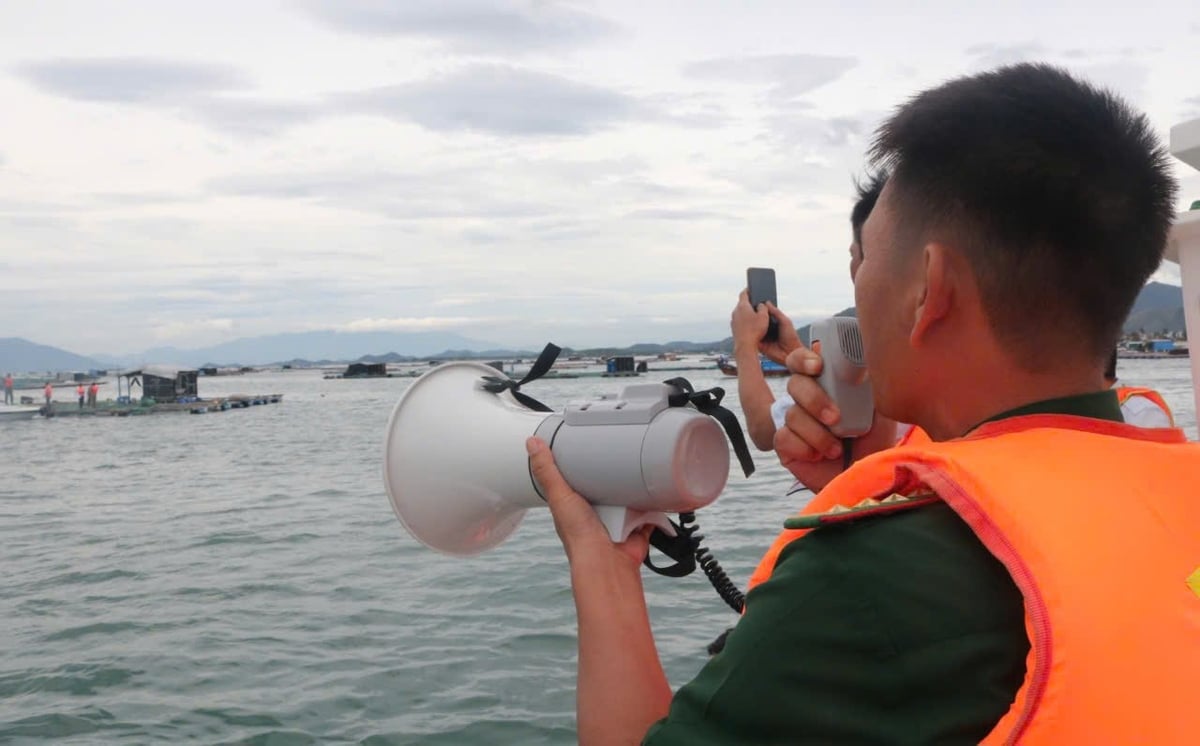
Authorities notify the storm and tropical depression paths so that aquaculture farmers can be informed and move their operations ashore for safe shelter. Photo: KS.
In the face of increasingly complex and unpredictable climate change developments, affecting nearly all sectors and localities, including marine farming, the Central Region Hydrometeorological Station plans to further strengthen its support for coastal aquaculture communities in a proactive, practical, and sustainable manner.
Specifically, the station will coordinate with local authorities to provide detailed forecasts and warning bulletins tailored to key aquaculture areas. These bulletins will integrate weather conditions, water environment, and marine ecosystems to help both local residents and authorities manage risks more effectively.
In addition, the station will utilize advanced forecasting models, including artificial intelligence technologies, to extend early warning lead times and enhance the reliability of weather and disaster forecasts, thereby providing people and local governments with more time to prepare.
Furthermore, the station will work with relevant departments to enhance the dissemination of disaster-related information through mass media, social networks, and local loudspeaker systems, ensuring timely communication with residents. It will also collaborate with local authorities and agencies to organize community outreach and training sessions to promote and guide the effective use of forecast information. This will help communities be more proactive in production, disaster response, and climate change adaptation.
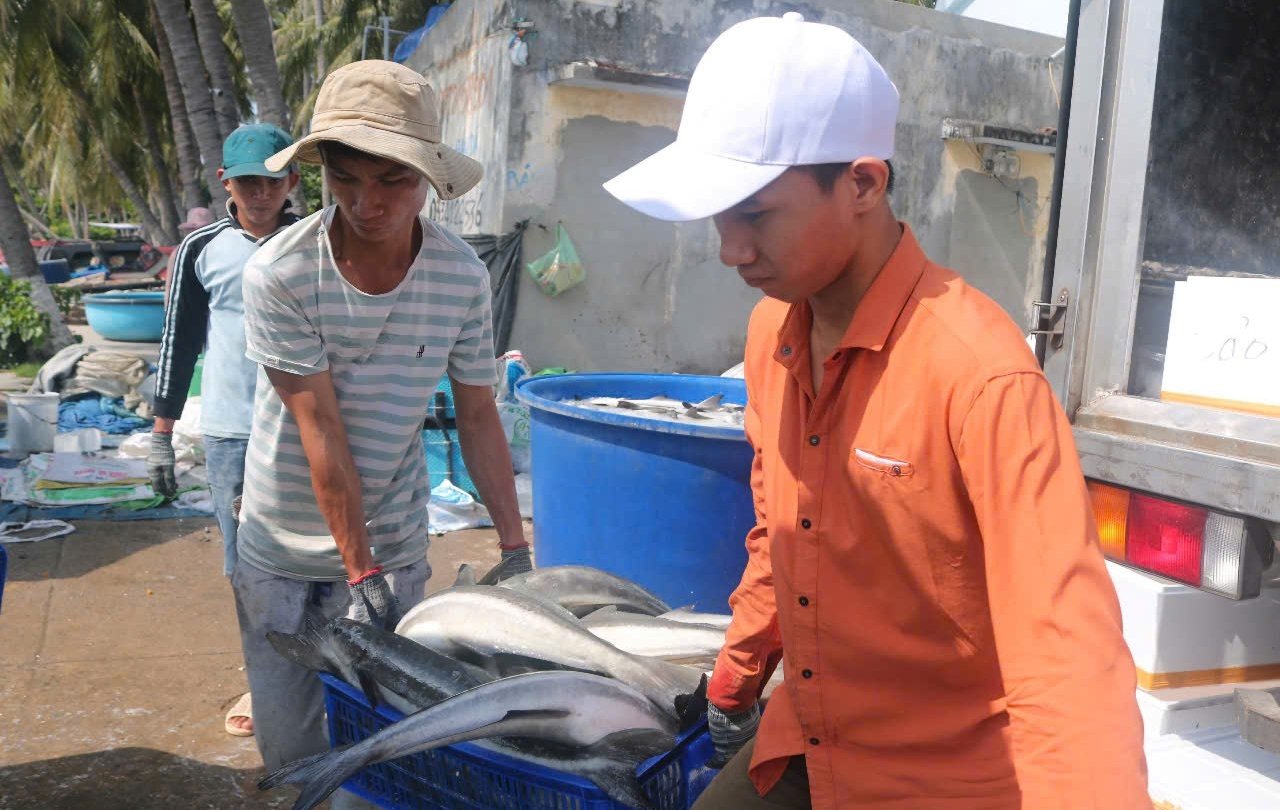
Farmers harvest fish that have reached market size ahead of the storm to reduce losses. Photo: KS.
According to Mr. Le Xuan Thai, to improve forecasting efforts, the province plans to invest in and establish automatic monitoring stations to measure parameters such as wind, waves, temperature, and salinity, along with buoy stations in key marine farming areas such as Van Ninh, Ninh Hoa, Nha Trang, and Cam Ranh. At the same time, it will strengthen and develop a specialized workforce dedicated to marine forecasting. The province will also organize outreach and training sessions on meteorology and hydrology to disseminate and guide the use of forecast information in aquaculture production.
Additionally, the province will enhance surveys and data collection in major aquaculture zones to develop impact scenarios for different types of natural disasters on specific farmed species and farming areas. It will also collaborate with enterprises to implement hydrometeorological service contracts, providing detailed and specialized forecasts for key farming areas to ensure the most effective aquaculture and harvesting operations.
According to Mr. Thai, in addition to enhancing forecasting and warning efforts and ensuring the reliability of weather bulletins, the Provincial Steering Committee for Natural Disaster Prevention, Search and Rescue, and Civil Defense recommends that individuals and businesses engaged in marine aquaculture regularly monitor weather forecast information, especially concerning hazardous conditions such as storms, floods, strong winds, high tides, and large waves, in order to proactively protect their assets and lives.
Translated by Phuong Linh

(VAN) The development of green, circular, and organic agriculture is becoming an essential direction for the Mekong Delta, helping farmers cut costs, boost profits, and build a sustainable production system.

(VAN) Eighty years of agriculture and environmental development in the Mekong Delta tell a story of constant adaptation and transformation - all driven by the shared goal of harmonizing production with environmental protection.

(VAN) Sustainable coconut cultivation is the key to achieving balance among three pillars: economic efficiency, ecological safety, and consumer trust.

(VAN) A wood pellet factory has been supporting forest growers certified under FSC standards to improve their income and promote sustainable forest protection.

(VAN) Associate Professor Dr. Pham Anh Tuan emphasized that clearly identifying target groups, production scale, and consumer markets is key to ensuring the sustainable development of Viet Nam’s coconut industry.

(VAN) More than 400 experts from domestic and international organizations attended the ACT Con 2025 conference, which aimed to connect technology developers with frontline conservation teams.

(VAN) Food irradiation technology is an innovative solution that extends shelf life and acts as a ‘golden visa’ enabling Vietnamese agricultural products to access the world’s most demanding markets.